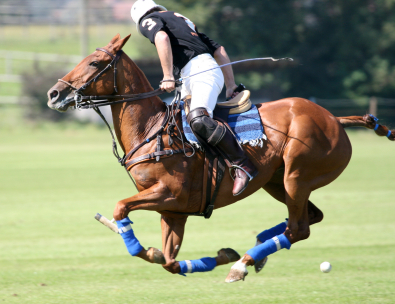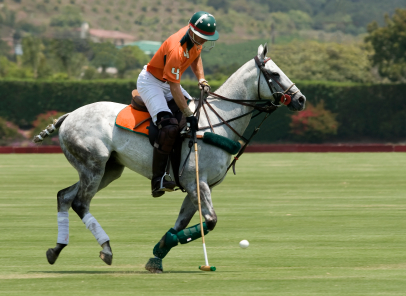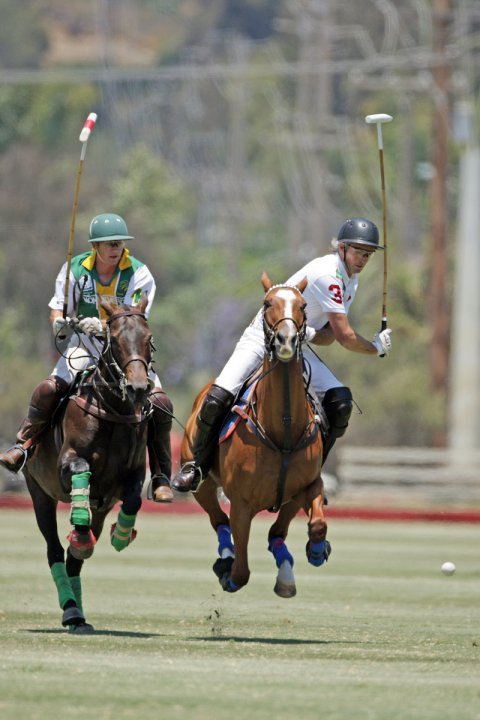
|
|
 |
||||||||||||||||||||
|
|
|||||||||||||||||||||
|
POLO PONIES By Jeannine Clark  away the afternoon watching one of the oldest and fastest team-sports in world history. away the afternoon watching one of the oldest and fastest team-sports in world history.A scene from a Merchant/Ivory film, perhaps? No - it's just another summer Sunday at the San Diego Polo Club in Rancho Santa Fe, California. But the real excitement doesn’t happen amidst the glitz and glamor of the attendees under the tent; it begins when players in colorful jerseys pound the field on horseback. “Oh, look at that swing! He’s just so graceful as he makes that millionaire’s shot,” announces Steve Lewandowski, a 20-year veteran with the San Diego Polo Club, as the players thunderously roar past the stands, mallets clacking, chasing down a soaring ball toward the goal. The sport is played fast and fierce, and players employ aggressive methods and strategies (as well as tremendous equestrian skill) in order to come out on top. During two Sunday matches, I talked with Lewandowski about the game, asking him questions like, “What’s a ‘millionaire’s shot’?”  “It’s when the ball goes right under the belly of the horse,” he answers between chukkers and quippy comments. As the smell of grass, steaming divots and cigar smoke wafts through the air, Lewandowski shares with me a wealth of knowledge - proceeding to school me in the history and language of polo: “It’s when the ball goes right under the belly of the horse,” he answers between chukkers and quippy comments. As the smell of grass, steaming divots and cigar smoke wafts through the air, Lewandowski shares with me a wealth of knowledge - proceeding to school me in the history and language of polo:It’s believed that polo originated in Northern Persia (now Iran) around 600 B.C.E., and hence has survived almost 2,600 years. Originally, it was a training exercise to prepare cavalry soldiers for battle, but by the mid-19th century, soldiers and merchants in Northern India had adopted a similar game played by Manipuri hillsmen that closely resembles what we know of the game today. Military officers imported the game to Britain in the 1860s, and the establishment of polo clubs throughout England and Western Europe followed after a formal codification of the rules. Polo is now played in over 50 countries worldwide, and has been played in the U.S. for over 125 years. The name ‘polo’ is derived from the Indian word pulu, which is the wood the ball is made from. A round of play is called a 'chukker,' which comes from the Sanskrit word for circle, or round. A match is played at breakneck speed, and consists of six chukkers, which combined last approximately 75-80 minutes. There are eight players total in each match: four on each team,  with each one ranked according to handicap. The best players have the highest handicaps, all the way up to 10, and the lowest-ranked players start at -2. (The average player is ranked between -2 to 2.) Many factors other than scoring go into a player’s ranking, such as understanding of the game, horsemanship, sportsmanship, seniority and playing ability. with each one ranked according to handicap. The best players have the highest handicaps, all the way up to 10, and the lowest-ranked players start at -2. (The average player is ranked between -2 to 2.) Many factors other than scoring go into a player’s ranking, such as understanding of the game, horsemanship, sportsmanship, seniority and playing ability. Most polo players have about 6-8 horses ready at each match, and trade off after each chukker - so each horse only plays in one chukker per game, or about 7 1⁄2 minutes total. In no other sport does a player depend so heavily on his animal partner for his success. (Polo players not only adore their horses, but many are huge animal lovers as well, often owning a bunch of other pets besides their ponies.) But it takes more than just a love of horses to play polo; the ability to own and train a stable of horses is part of what makes the game notoriously known as “the sport of kings.” However, Lewandowski assures me, there are all levels of play, and having just 1-2 horses can get anyone started playing polo. In Argentina, polo is the national sport and is played by the middle class; so most anyone can play polo there, because it’s actually affordable. Back on the field, I watch great sportsmanship and  cooperation between two players as one politely uses her mallet to lift the fallen mallet belonging to an opposing player. (Yes, I did say “her.”) Polo is one of the only mixed-gender team sports. It’s also pro/am, meaning that two players on the team are professionals, and two are amateurs, which makes it doubly-unique. cooperation between two players as one politely uses her mallet to lift the fallen mallet belonging to an opposing player. (Yes, I did say “her.”) Polo is one of the only mixed-gender team sports. It’s also pro/am, meaning that two players on the team are professionals, and two are amateurs, which makes it doubly-unique.After the first match, I manage to steal a few minutes to speak with the handsome Roberto Estudillo, member of the winning team, San Fernando/Tritech. Estudillo is the epitome of charm, a true Latin gentleman with a twinkle in his eyes and a gracious, attentive gaze. I ask him how it feels to be a winner and he answers, “I’m happy to be a winner, but everyone who plays is a winner.” Then, he shares with me what he loves so much about the game. “It’s very exciting," he tells me. "With lots of adrenaline on the field. Polo is like life, very daring and dangerous.” Indeed it is a rough sport; many players get injured during play, suffering from falls and broken bones. I ask him about his horses, and he tells me he has 12. “I can tell immediately if a horse will be a great polo pony by the way he reacts to the field,” he tells me. “If he  is hesitant to get on the field, that shows he doesn’t want to play. But if he can’t wait to run onto it, that’s his way of letting you know. Horses are very intelligent.” is hesitant to get on the field, that shows he doesn’t want to play. But if he can’t wait to run onto it, that’s his way of letting you know. Horses are very intelligent.”I thank Estudillo for his time. As he kisses my hand and replies, “Mucho gusto,” I feel like Julia Roberts. If you want to live out your Pretty Woman fantasies by being invited onto the field for a half-time divot stomp, just attend a polo match in sunny Rancho Santa Fe, or set aside some time to see a match played in nearby Los Angeles or Santa Barbara. Of course, the best of all possible worlds would be to travel to India, Argentina, or any one of a number of foreign countries where polo is also played, to witness one of the oldest and most exciting team sports in history. FAST FACTS Will Rogers Equestrian Club (Los Angeles, CA) (818) 509-9965 www.willrogerspolo.org Santa Barbara Polo Club (Santa Barbara, CA) (805) 684-5819 www.sbpolo.com San Diego Polo Club (Rancho Santa Fe, CA) (858) 481-9217 www.sandiegopolo.com Meadowbrook Polo Club (Long Island, NY; the oldest polo club in the U.S.) (516) 626-0010 www.meadowbrookpolo.com Mashomack Polo Club (Pine Plains, NY) (561) 676-2879 www.mashomackpolo.com Photo credits: Dominique Lemarie; iStockphoto |
|
|
|
|
| Site Map |